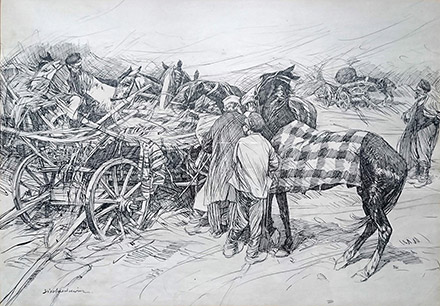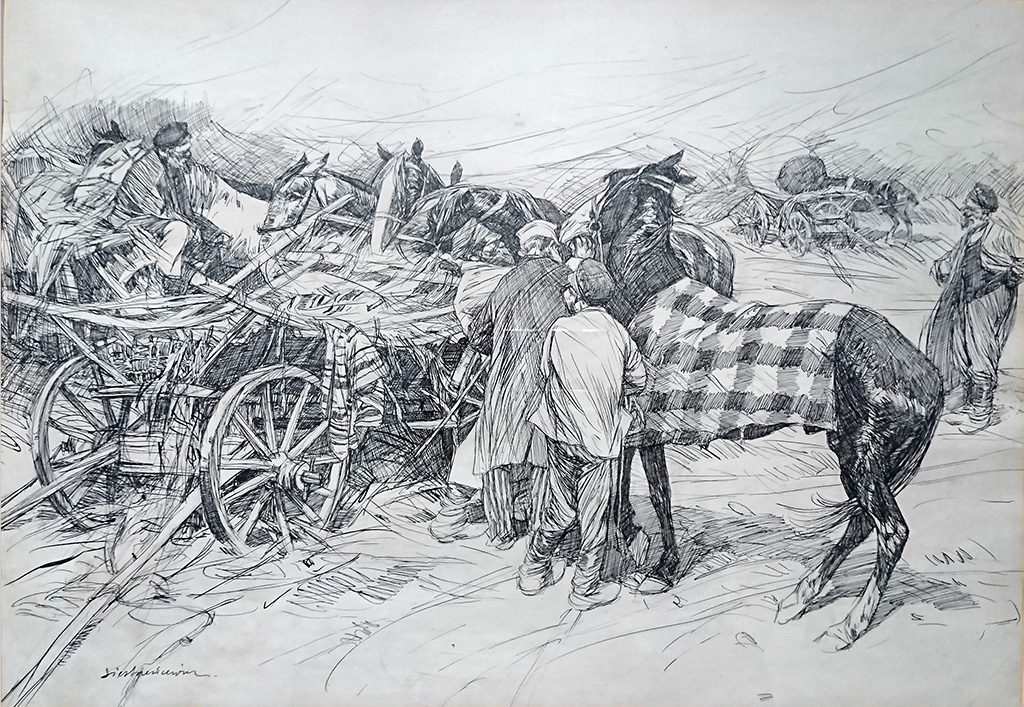
STANISŁAW
BOHUSZ-SIESTRZEŃCEWICZ
(1869–1927)
The realisation of the presentation funded
as part of the programme EU Interreg Lietuva-Polska
Project: LT-PL-5R-389
Horse’s Examination
Horse’s Examination
[Horse Covered with a Saddle-Cloth Standing by a Carriage]
circa 1900, 43 x 62,5 cm
drawing, feather, ink, paper
Horse’s Examination is one of many compositions by Stanisław Bohusz-Siestrzeńcewicz which deal with a genre theme, showing a suburban Vilnius market with a scene of examining a horse put up for sale.
Horse’s Examination is an open composition, based on diagonal lines, set out by the way the cart is placed in the foreground. A wagon filled with hay constitutes a counterbalance for the nearby scene of examining the horse, which, on the first look, can be identified as secondary since its main hero, placed on the axis of the presentation, is turned backwards. Such an arrangement of main characters is a contradiction to the academic rules of building a composition. The effect, however, results in an increased interest of the viewer.
All the heroes of the presentation participate in the market transaction, directly or by waiting for the results of the examination. Seeming indifference of the man on the cart is contrasting with the focus of the peasant, willing to buy the horse. The author used a peculiar conversion of the roles shown in the picture. The main hero was placed backwards and his adversaries were moved to the periphery of the presented space.
The scene is drawn dynamically, intuitively and it is framed fragmentarily without keeping the classical principles of a composition. It has a journalistic quality. The author brilliantly captured the movement of animals and people. He skillfully built a psychological tension and rendered the authenticity of a depicted scene. What catches the attention is the empathetic depiction of the pain and fear of the horse during the examination. The drawing is fast, the line drawn with a steady hand, in a sweeping way in some sections. Some fragments, which are blackened strongly with a thicket of lines, contrast with white spaces of untouched paper. Technical proficiency is matched with the observational sense of the artist.
First drawings of genre themes (pictures of markets, carriages riding though crowded fairs, flirtations between country people awaiting by their carts, peasants’ conversations) were created by Stanisław Bohusz-Siestrzeńcewicz already during his studies. They were proficiently drawn and contained motives that were exotic for Parisian or Munich audiences. Because of this, they attracted attention and were easily sold. The artist therefore repeated the proven solutions; he modified the details and duplicated the forms. Despite this fact, the drawings are rightly considered pieces of high artistic value, a proof of talent and skill of the artist. Drawn dynamically and with ease, they contain lightness and charm of the picturesque events of borderland life.
Feather drawings were published in a file Feather Drawings by Stanisław Bohusz-Siestrzeńcewicz in Vilnius in 1813 and then in 1928, after his death. The first album was 18 card-long and the second 15. The introduction was written by a painter and art critic: Henryk Piątkowski.
The albums were declared masterpieces of drawing art and granted the artist the title of an outstanding drawer. They were valued for an observational sense, a skill of depicting movement and the character of people and forms, ease of drawing, picturesqueness of the composition and the authenticity of the scenes.






